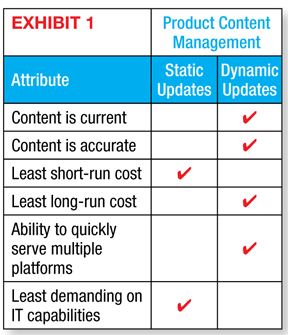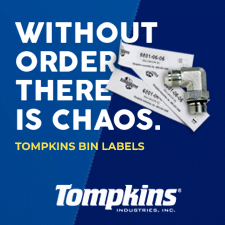The Product Content Value Chain
Competing for digital sales in distribution
By Scott Benfield
Our 2016 research on e-commerce for distributors finds a significant gap in online performance. For the past three years, 20 percent of distributors transact 80 percent of online sales. The performance gap is closing, slightly, as the technologically challenged verify sales loss. However, firms that lead in e-commerce spend more money on technology and have larger budgets for online needs, including the development of product content.
The research project was conducted jointly with Industrial Supply magazine, the Industrial Supply Association (ISA), Manufacturers Alliance for Productivity and Innovation (MAPI), and sponsored by Epicor Software Corporation.
It is difficult to underestimate the customer’s need and desire for up-to-date and accurate content. In our 2015 survey of 250 MRO customers, “current and reliable” product content ranked at the top of e-commerce attributes, above “fair and competitive pricing” and “inventory status and accurate delivery estimates.” Numerous surveys have found product content to be a prerequisite for ongoing orders, and a recent Forrester project found that quality content, among B2B buyers, was the deciding factor for 31 percent of all final purchases.
The movement of product content across the value chain — from manufacturer to distributor, and distributor to customer — is a gargantuan task. Most products have attributes that number between 45 to 55, and several of these are changed on a regular basis. In essence, for every 1,000 SKUs, there are 45,000 to 55,000 attributes. If a wholesaler stocks 20,000 SKUs, the product content attributes can easily number over 1 million. The need for a tool to manage content and populate the content management system is a challenge for most distributors, and of real concern to manufacturers that rely on their distributors to grow sales. Hence, we believe that management of the product content value chain is necessary to maintaining channel relationships.
Dynamic and Static Content Efforts
There are two primary means of updating product content for the e-commerce effort: static updating and dynamic updating. Static updating uses a variety of IT and manual processes to update the content management system (CMS). Distributors are well aware of static processes, as they have used them to update the ERP system and content attribute fields for each SKU. Much of the ERP system content, however, is not suitable for e-commerce, including short descriptions for product and the ability to develop robust taxonomies. Static updating is often a function shared in the marketing and purchasing departments, and revolves around the changes to price and product from major manufacturers. Much of the updates involve spreadsheet uploads to the ERP system.
Dynamic content management is done via Product Information Management (PIM) software and provides a gateway, on-boarding, content verification, and ability to serve multiple platforms for SKU-based attributes. PIM software appeared in Europe during the earlier days of B2C e-commerce and has since migrated to North America with B2B specialized functionality.
 Exhibit 1 displays some of the more telling differences in the content updating systems. For an initial low cost, most distributors opt for a static system, with the added benefit that it does not tax the IT capability, which is almost always under heavy demand as the industry digitalizes. Dynamic updating, however, holds a clear lead in being more accurate and current, while offering a lower long-term cost solution than static approaches. As online commerce increases, the content will be used in multiple publication options, from product catalogs, to vendor-specific programs, video links, etc. PIM software offers these capabilities, and are often overlooked by distributors that believe that standard e-commerce is the singular channel for content usage.
Exhibit 1 displays some of the more telling differences in the content updating systems. For an initial low cost, most distributors opt for a static system, with the added benefit that it does not tax the IT capability, which is almost always under heavy demand as the industry digitalizes. Dynamic updating, however, holds a clear lead in being more accurate and current, while offering a lower long-term cost solution than static approaches. As online commerce increases, the content will be used in multiple publication options, from product catalogs, to vendor-specific programs, video links, etc. PIM software offers these capabilities, and are often overlooked by distributors that believe that standard e-commerce is the singular channel for content usage.
Our experience and research gives a clear advantage to dynamic product content via PIM software, and we believe that distributors that are serious about e-commerce will need to engage software to manage and update their content in the near future.
Content Management in the Distribution Organization
Considerable debate is underway regarding which function in the organization is responsible for online content. A growing majority of firms place the responsibility in the e-marketing part of the organization. Little attention, unfortunately, is given to the varying parts of the organization that use and update the content. We encourage distributors to plan out the content management organization, including:
- Development, maintenance, and publishing of the product taxonomy
- Assigning product managers and experts with authority to manage and change specific areas of the product taxonomy
- Users of the content and their unique needs and schedules
- On-boarding of vendor content and working with discrete vendors on content issues, including format, timeliness, accuracy, etc.
If the previous tasks seem foreign, they are for many distributors. However, our premise is that product content and its quality assurance and timeliness is absolutely essential for online sales success and perpetuating the manufacturer partnership. We expect that distribution organizations will have or need to build the organization capabilities to manage content across the value chain.
Selecting a Qualified PIM
Our enthusiasm for PIM software is founded in the experience of billion dollar distribution firms that are well-funded in e-commerce technology, have millions of SKUs online, and sell 25 percent or more of their volume online. Many of these firms purchased PIM technology and developed the content management function before investing in a new B2B e-commerce platform. Product content came first, before the transaction platform upgrade.
A PIM should do several things:
- On-board a variety of file formats from vendors (JPG, PDF, XML, flat files, spreadsheets, etc.)
- Check incoming data quality for correct format and regular changes, including product cost, list price, and other attributes
- Maintain a content library or repository for user-defined attributes and related variables
- Provide relationship management tools to assign products to the correct taxonomy or catalog structure
- Offer a way to enrich and curate content, including unstructured data (picture files, videos) and automate these needs wherever possible
- Use a workflow logic that directs content activities across the enterprise and outside to approved users
- Include content publication tools that give users the chance to publish different media (print or online) for marketing purposes
The cost of PIM software and integration varies significantly across various providers. We recommend a thorough vetting of the technology across potential suppliers.
Several distributor marketing associations provide content generation for their members. These are often buying groups that aggregate vendors to drive volume and cost concessions. However, these efforts may not offer a software solution to manage content needs across the channel, and they often do not cover all of the products a particular member sells. Hence, while we believe these efforts have a positive effect in that they ensure quality data and content updates, they can’t practically offer a full solution for their members.
Distributors are beginning to realize the need for quality content that is robust and current. Online buyers are, more often than not, unforgiving if errant content recommends the wrong product, and especially if the product is installed and elicits downtime. Additionally, errors in pricing, functionality, configuration, etc., are reasons that users require the most accurate content available. The cost of content management is significant, well into six or seven figures for the beginning years of content management software and integration. The function cannot be outsourced to firms that “strip” out data, or marketing groups that generate content for members. Without quality content, as online purchases increase, the distribution firm will lose sales and customers, and impair relationships with their vendors. We place the discipline and funding of product content at the very top of the e-commerce effort.
 Scott Benfield is a Chicago-based consultant for B2B channels in areas of digital commerce and general management. Find him at www.benfieldconsulting.com, (630) 428-9311 or scott@benfieldconsulting.com. For white papers with additional findings from his research, visit www.industrialsupplymagazine.com and search for the IS eResource Guide.
Scott Benfield is a Chicago-based consultant for B2B channels in areas of digital commerce and general management. Find him at www.benfieldconsulting.com, (630) 428-9311 or scott@benfieldconsulting.com. For white papers with additional findings from his research, visit www.industrialsupplymagazine.com and search for the IS eResource Guide.
This article originally appeared in the July/August 2016 issue of Industrial Supply magazine. Copyright 2016, Direct Business Media.













